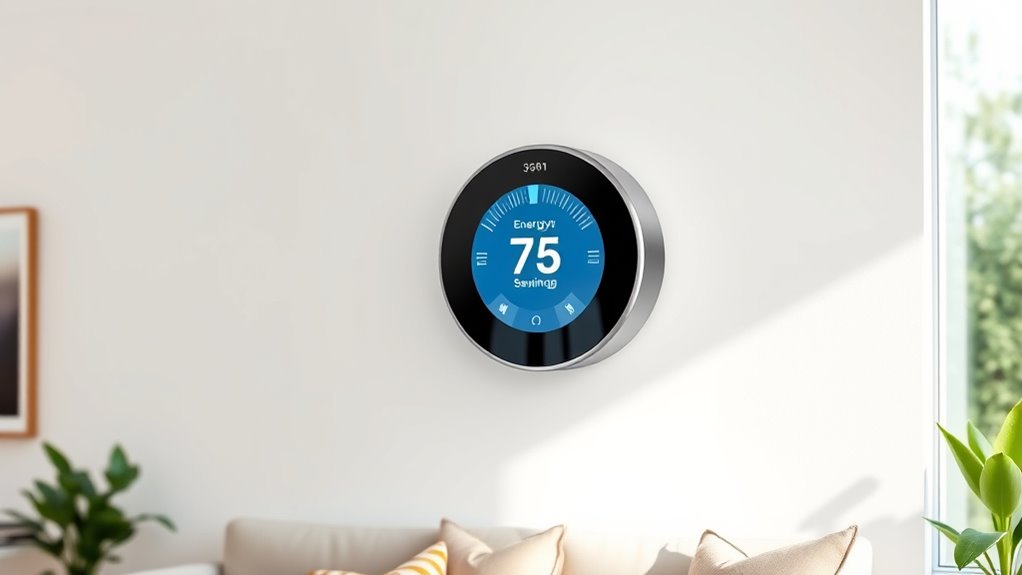If you’re looking for affordable smart thermostats that can save you money and energy, I’ve got some great options for you. Models like the ecobee Smart Thermostat and Sensi Smart Thermostat are known for their impressive energy savings—up to 26% and 23%, respectively. Plus, many offer easy installation and user-friendly features. Want more details on the top picks and what to evaluate? There’s plenty more to explore!
Key Takeaways
- Energy Savings: Smart thermostats like ecobee Premium and Sensi Touch offer significant annual savings of up to 26% and 23% respectively on HVAC costs.
- Installation Ease: Many models provide easy DIY installation with app-guided instructions, though some may require a C-wire for compatibility.
- Smart Features: Look for thermostats that offer voice control, geofencing, and app connectivity to enhance energy management and convenience.
- User Experience: Check user reviews for feedback on performance and support, as experiences can vary across different models.
- Energy Star Certification: Choose ENERGY STAR certified thermostats to ensure you are selecting energy-efficient options that promote savings and sustainability.
Inkbird ITC-308 Digital Temperature Controller
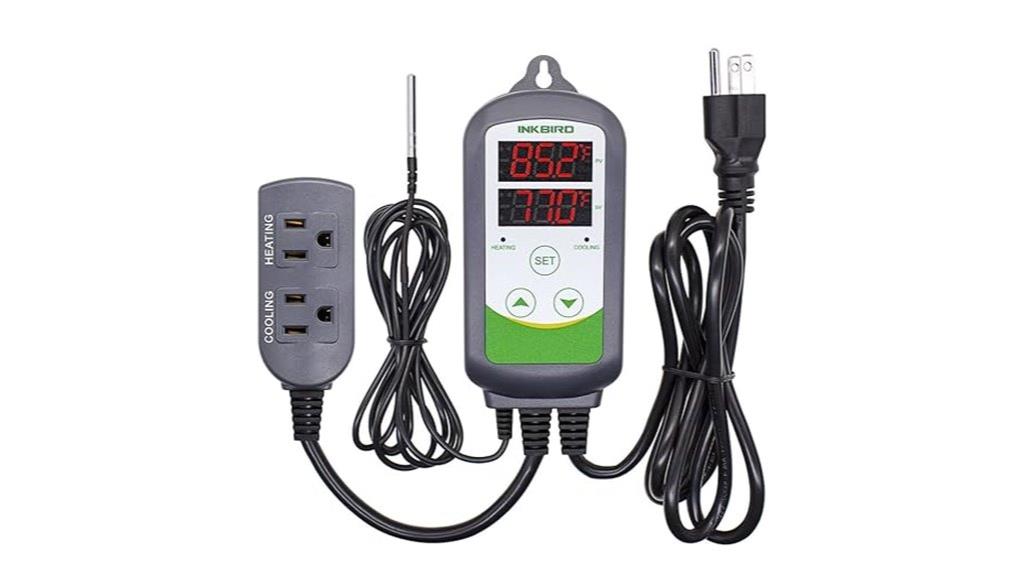
If you’re a homebrewer or a reptile enthusiast, the Inkbird ITC-308 Digital Temperature Controller is an excellent choice for maintaining precise temperature control. I love its plug-and-play design, making setup a breeze. With dual relay outputs, it simultaneously manages heating and cooling, perfect for my fermentation projects. The dual display lets me monitor real-time temperatures effortlessly. Plus, the high/low-temperature alarms keep me informed. I appreciate its WiFi connectivity, allowing me to check settings from my phone. Overall, the Inkbird ITC-308 has become an essential tool for me, ensuring my brews and reptiles thrive in the ideal environment.
Best For: Homebrewers and reptile enthusiasts seeking reliable and precise temperature control for their projects.
Pros:
- Easy plug-and-play design allows for quick and hassle-free setup.
- Dual relay outputs enable simultaneous heating and cooling management.
- WiFi connectivity provides remote monitoring and adjustments via smartphone.
Cons:
- Some users report automatic adjustments upon setting changes can be inconvenient.
- Limited logging frequency options, with suggestions for improvement noted.
- Shorter probe wire could be a drawback for larger setups or distances.
Sensi Smart Thermostat (ST55)
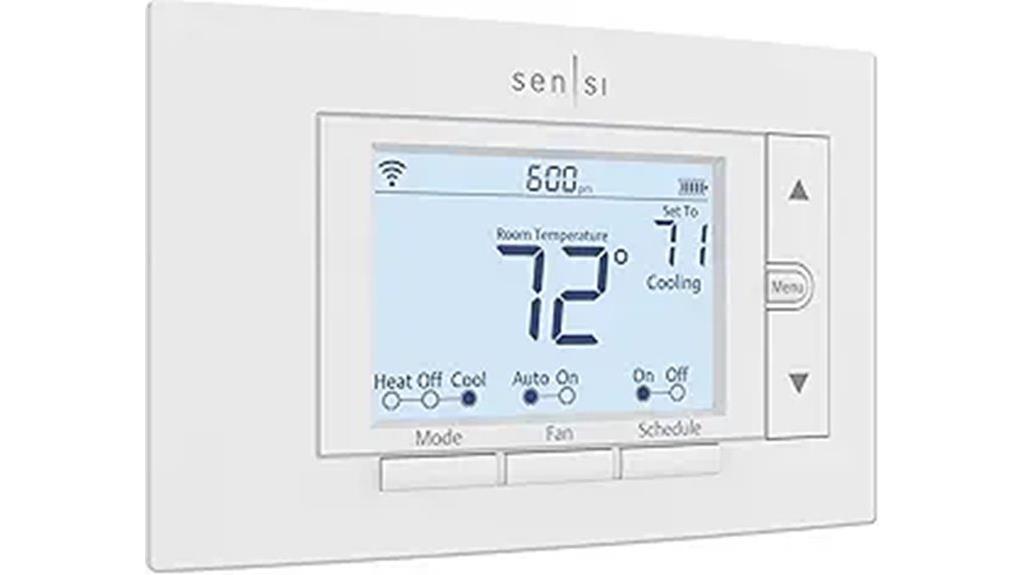
The Sensi Smart Thermostat (ST55) stands out as an excellent choice for budget-conscious homeowners seeking a user-friendly, energy-efficient solution. I love its Wi-Fi capability and Energy Star certification, which can help cut HVAC costs by around 23%. Installation is a breeze, thanks to the app’s step-by-step instructions and no need for a common wire in most cases. I appreciate the smart maintenance features, like performance monitoring and alerts for issues. Plus, it offers flexible scheduling and remote access. Although it lacks Bixby compatibility, the overall user experience is fantastic, making it a worthy investment for anyone looking to save energy and money.
Best For: Budget-conscious homeowners seeking a user-friendly and energy-efficient solution for climate control.
Pros:
- User-friendly installation process with step-by-step app instructions.
- Wi-Fi enabled with the ability to monitor and control settings remotely.
- Smart maintenance features, including performance monitoring and equipment alerts.
Cons:
- Lacks compatibility with Bixby for voice control.
- Limited daily usage report details may not satisfy all users.
- Occasional issues with settings not saving immediately, leading to potential user frustration.
Google Nest Thermostat – Smart Wifi Thermostat
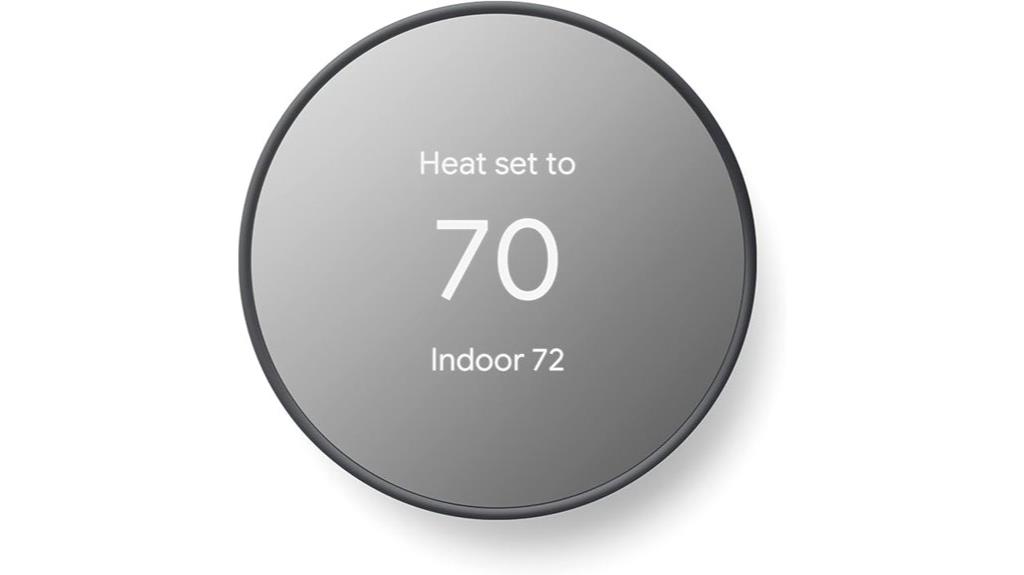
For anyone looking to enhance their home’s energy efficiency without breaking the bank, the Google Nest Thermostat stands out as an excellent choice. This compact, battery-powered device connects via Wi-Fi and offers remote control through the Google Home app. I love how it automatically adjusts the temperature when I’m not home, helping me save energy effortlessly. Plus, its ENERGY STAR certification and savings finder feature suggest tweaks for even more savings. Installation is typically quick, and I appreciate the alerts for HVAC issues. It’s a smart investment that keeps my home comfortable while being easy on my wallet.
Best For: Homeowners looking for an energy-efficient thermostat that offers smart features and remote control capabilities.
Pros:
- Easy installation typically taking 30 minutes or less.
- Automatically adjusts temperature when home is empty, enhancing energy savings.
- Compatible with voice control through Google Assistant and Amazon Alexa.
Cons:
- May require a C wire for some heating and cooling systems, limiting compatibility.
- Supports only 2-stage heating or cooling, which may not suit all homes.
- Some users report a desire for more intuitive scheduling options in the app.
ecobee Smart Thermostat Enhanced – Programmable Wifi Thermostat
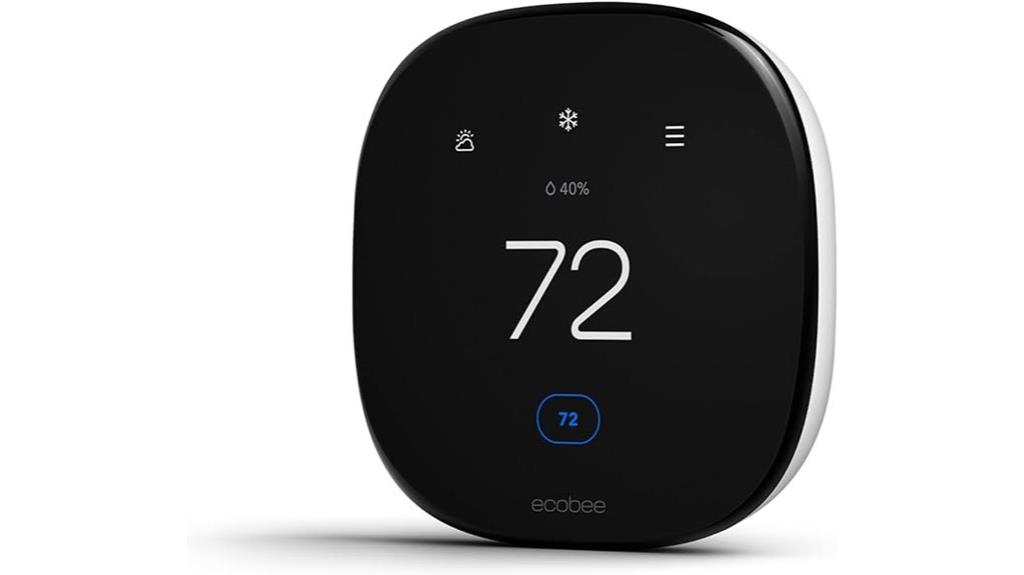
Looking to cut down on your energy bills while maintaining comfort in your home? The ecobee Smart Thermostat Enhanced is a fantastic option. It can save you up to 26% annually on heating and cooling costs, plus it’s ENERGY STAR certified. I love how it adjusts the temperature when I’m away, ensuring my home isn’t unnecessarily heated or cooled. With features like preheating and humidity control, it keeps my space comfortable year-round. Installation is a breeze, and I can control it from anywhere using the app. Plus, its durability means I won’t worry about battery replacements anytime soon.
Best For: Those looking to save on energy bills while enjoying customizable comfort and convenience in their homes.
Pros:
- ENERGY STAR certified, providing up to 26% savings on heating and cooling costs.
- Easy installation process, typically completed in about 45 minutes.
- Control from anywhere via the ecobee app and smart home platforms.
Cons:
- Some users may find the scheduling interface more complicated compared to competitors like Nest.
- SmartSensor for room-specific monitoring is sold separately, adding to the overall cost.
- Limited compatibility with non-24VAC HVAC systems may require additional considerations during installation.
Honeywell Home Wi-Fi Smart Color Thermostat
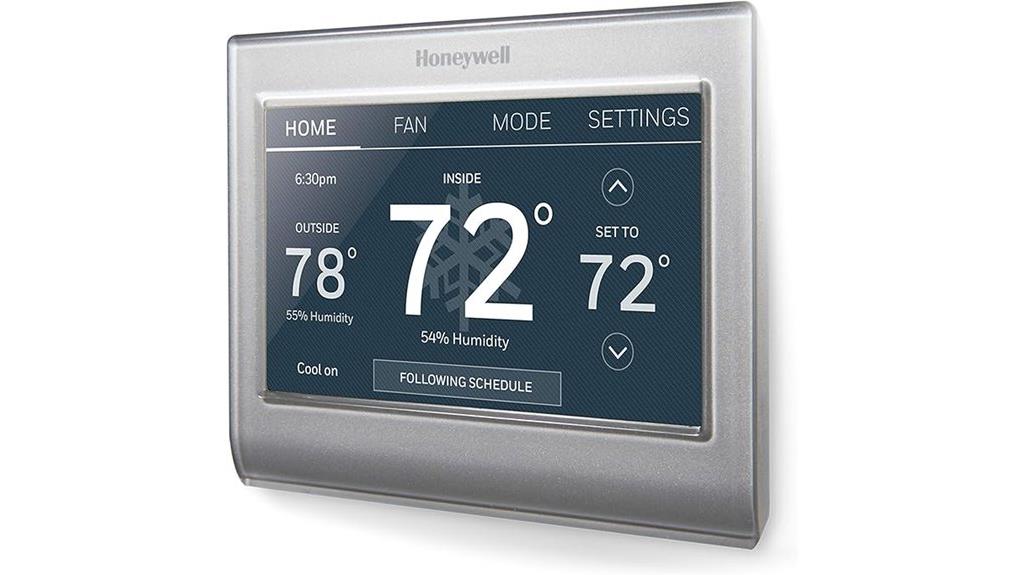
If you’re someone who values customization and energy efficiency in your home, the Honeywell Home Wi-Fi Smart Color Thermostat is an excellent choice. This thermostat features a vibrant touchscreen that you can personalize to match your décor. With its 7-day programmable schedule and energy-saving capabilities, it helps me stay comfortable while cutting down on costs. I love that I can control it remotely through the app, adjusting settings with ease. Plus, its Energy Star certification means I receive monthly energy reports and may qualify for rebates. Overall, it’s a smart investment for any energy-conscious homeowner.
Best For: Homeowners looking for a customizable, energy-efficient thermostat that offers remote management capabilities.
Pros:
- Customizable color touchscreen allows users to personalize the appearance to match home décor.
- Energy Star certified, providing monthly energy reports and potential rebates for energy savings.
- Remote control via smartphone app enables easy management of settings from anywhere.
Cons:
- Requires a C-wire for installation, which may not be available in all homes.
- Some users may find the customizable color feature less useful than expected.
- Installation can be complex for certain wiring setups, potentially necessitating professional help.
Amazon Smart Thermostat – Works with Alexa and Ring
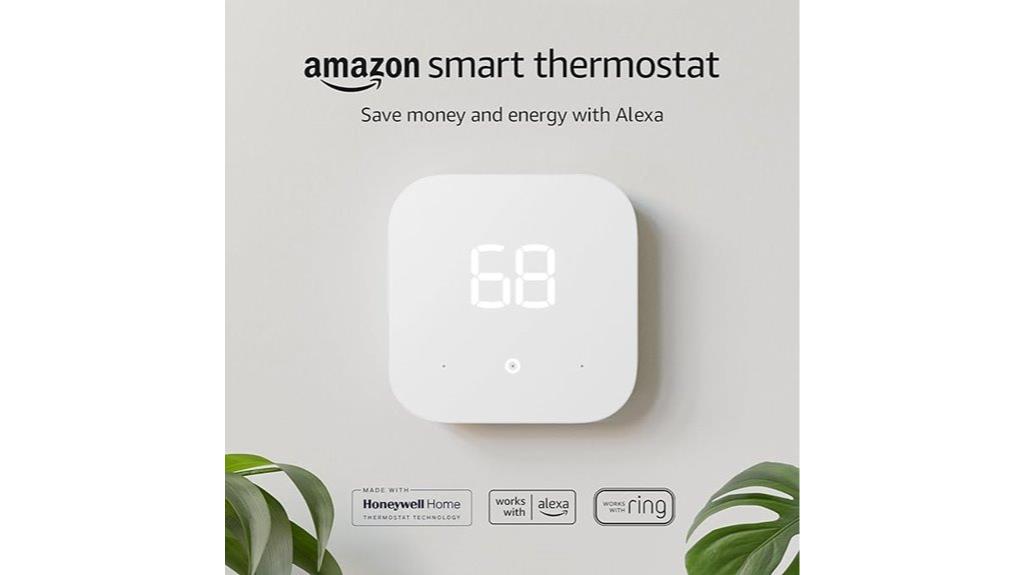
The Amazon Smart Thermostat stands out as an excellent choice for anyone wanting to seamlessly integrate smart technology into their home while enjoying energy savings. It works with most 24V HVAC systems and connects effortlessly with Alexa and Ring for easy temperature control. I love how it automatically adjusts settings based on my schedule and activity, saving me an average of $50 annually on energy bills. Plus, the user-friendly installation process made setup a breeze. With its energy dashboard and ongoing updates, I feel confident in my purchase, knowing it’s backed by Honeywell’s 130 years of experience.
Best For: Homeowners looking to upgrade to a smart thermostat while reducing energy costs and enhancing convenience through automation.
Pros:
- Energy savings: Average savings of $50 annually on energy bills due to ENERGY STAR certification.
- Easy integration: Works seamlessly with Alexa and Ring for convenient temperature control and automation.
- User-friendly installation: Guided setup through the Alexa app simplifies the installation process.
Cons:
- Compatibility limitations: Not compatible with 110-240V HVAC systems, which may limit its use in some homes.
- Potential installation challenges: Some users report needing additional components for specific setups, which can complicate the process.
- User experience issues: Occasional problems with scheduling and network reconnection after power loss have been noted by users.
ecobee Smart Thermostat Premium with Smart Sensor
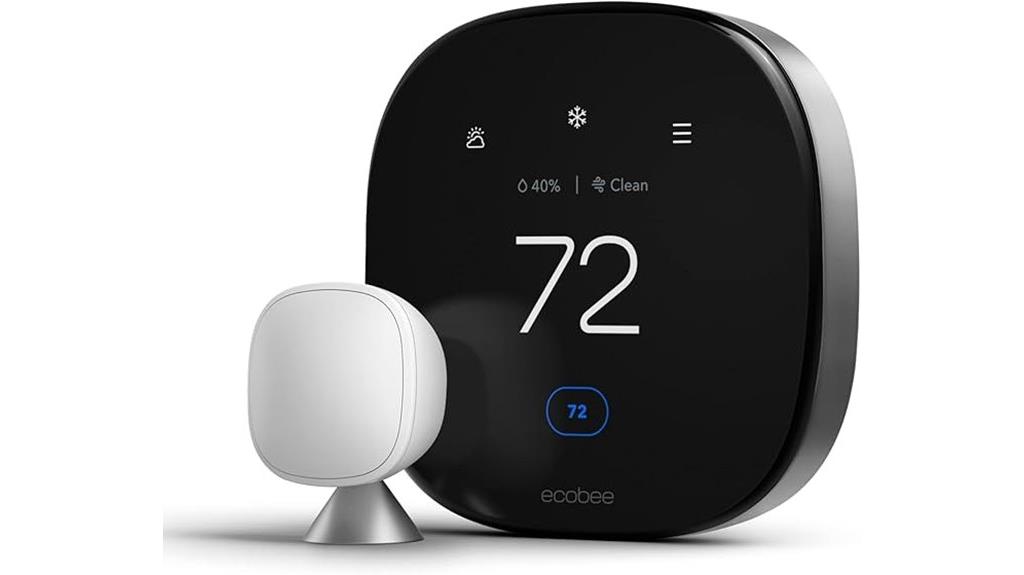
For homeowners seeking a blend of comfort and energy savings, the ecobee Smart Thermostat Premium with Smart Sensor stands out as an excellent choice. This ENERGY STAR certified device can save you up to 26% on heating and cooling costs annually. Its SmartSensor adjusts temperatures in key rooms, eliminating hot or cold spots. With compatibility across multiple platforms like Siri, Alexa, and Google Assistant, controlling your home’s environment becomes effortless. Plus, the air quality monitor and safety features like smoke alarm detection guarantee you’re always informed. Its sleek design and intuitive interface make it a perfect addition to any smart home.
Best For: Homeowners who want to enhance comfort, achieve energy savings, and improve air quality in their smart homes.
Pros:
- Energy Savings: Can save up to 26% on heating and cooling costs annually.
- Smart Features: Includes an air quality monitor, smoke alarm detection, and home security alerts.
- Wide Compatibility: Works with major voice assistants and multiple HVAC systems for easy integration.
Cons:
- Installation Complexity: May require professional installation, especially for homes without a C-Wire.
- Cost: Higher initial investment compared to standard thermostats.
- Limited DIY Troubleshooting: Some users may find troubleshooting issues challenging without professional help.
Sensi Touch 2 Smart Thermostat (ST76)
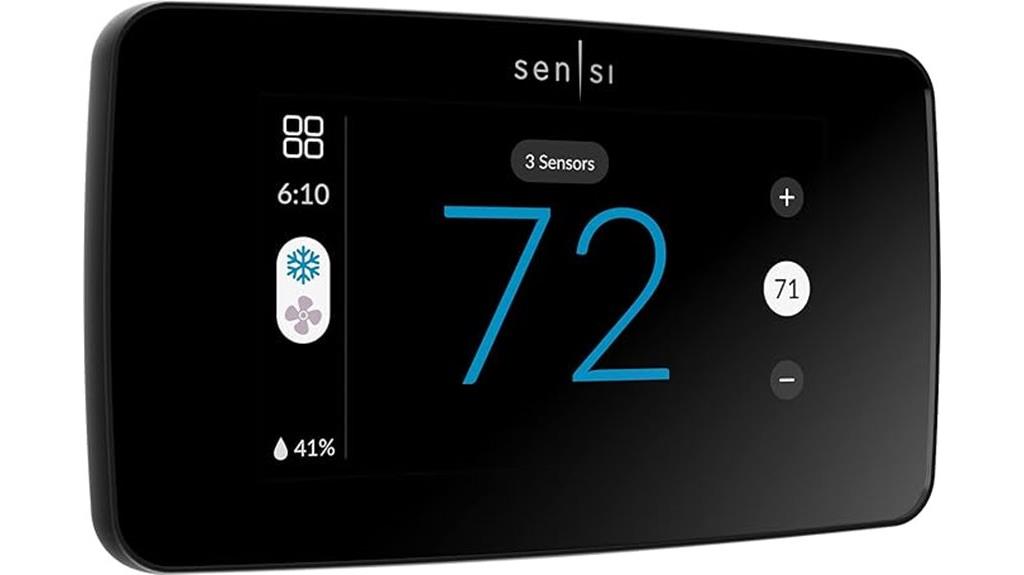
Looking for a reliable and user-friendly smart thermostat? The Sensi Touch 2 (ST76) might just be what you need. With its colorful touchscreen and easy DIY installation, I found setting it up a breeze. It connects to Wi-Fi, allowing me to control my home’s temperature from anywhere. Plus, I appreciate that it’s Energy Star certified, helping me save around 23% on HVAC usage. The integration with Amazon Alexa and Google Assistant adds to its convenience. If you want to enhance temperature control, consider adding Sensi Room Sensors. It’s a great investment for both comfort and savings!
Best For: Homeowners seeking an easy-to-use, energy-efficient smart thermostat that integrates with smart home systems.
Pros:
- User-friendly installation with intuitive app guidance makes setup straightforward.
- Significant energy savings of approximately 23% on HVAC usage through flexible scheduling.
- Smart home compatibility with voice control via Amazon Alexa and Google Assistant.
Cons:
- Initial Wi-Fi connection issues may arise for some users during setup.
- C-Wire requirement can complicate installation for homes lacking this wiring.
- Additional room sensors sold separately may be necessary for optimal temperature control.
Vine WiFi Smart Thermostat with Touchscreen Display
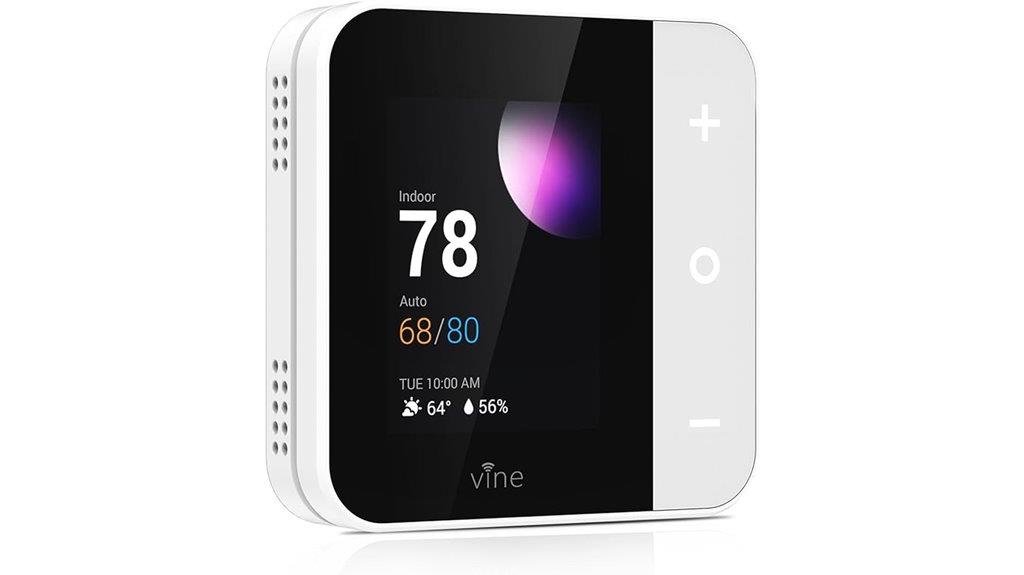
With its user-friendly 2.8-inch LCD touchscreen, the Vine WiFi Smart Thermostat stands out as an excellent choice for tech-savvy homeowners seeking to enhance their energy management. This thermostat is compatible with 90% of HVAC systems, making it versatile for most homes. I love its 7-day scheduling and Auto Home/Away mode, which help optimize energy usage effortlessly. Plus, I can control it remotely via the Vine or Smart Life app. Although some users report issues with support and accuracy, its ENERGY STAR certification promises savings. Just keep in mind the C-Wire requirement for installation. Overall, it’s a solid investment!
Best For: Tech-savvy homeowners looking for a versatile and energy-efficient smart thermostat.
Pros:
- User-friendly 2.8-inch LCD touchscreen for easy navigation.
- Compatible with 90% of HVAC systems, offering widespread applicability.
- ENERGY STAR certified, promoting energy savings and reducing HVAC expenses.
Cons:
- Requires a C-Wire for installation, which may necessitate an adapter for some homes.
- Some users report issues with heating/cooling not activating and inaccurate temperature readings.
- Customer support experiences may vary, with reports of slow responses and challenges in troubleshooting.
Honeywell Home T5 WiFi Smart Thermostat (RTH8800WF2022)
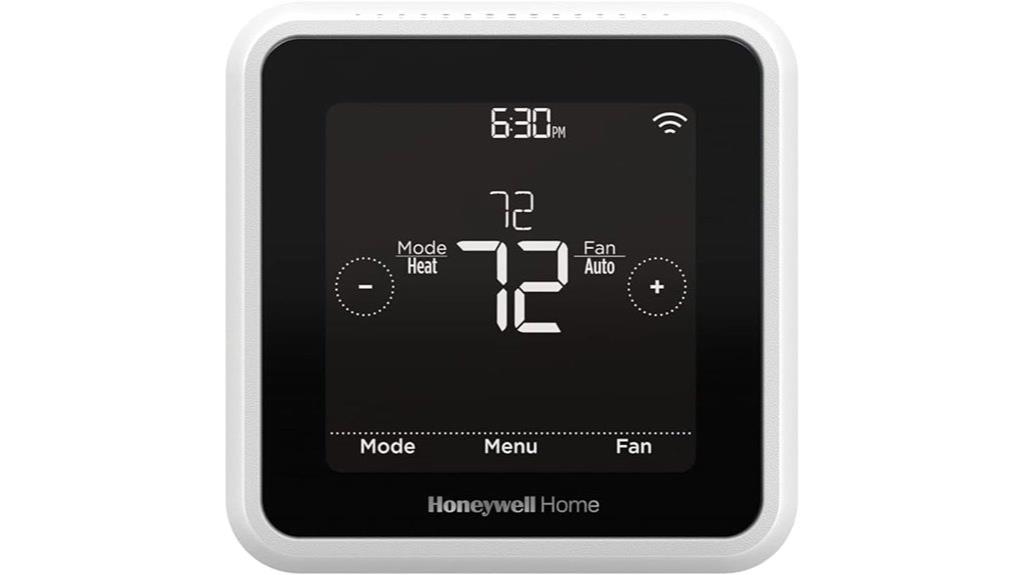
The Honeywell Home T5 WiFi Smart Thermostat (RTH8800WF2022) stands out as an ideal choice for tech-savvy homeowners who want to optimize their energy usage without sacrificing comfort. With its 7-day programmable schedule and geofencing technology, I can control my home’s temperature from anywhere using my smartphone. It’s ENERGY STAR certified, promising 8-16% savings on heating and cooling bills. Plus, it works seamlessly with Alexa and Google Assistant. Installation is straightforward, though you might need a C-wire. Overall, its sleek design and user-friendly features make it a smart investment for anyone looking to enhance their home’s efficiency.
Best For: Tech-savvy homeowners looking to optimize energy usage and control their home’s temperature remotely.
Pros:
- 7-day programmable schedule allows for flexible temperature control that adapts to your lifestyle.
- ENERGY STAR certified for potential savings of 8-16% on heating and cooling bills.
- Compatible with smart home systems including Alexa, Google Assistant, and Apple HomeKit for convenient voice control.
Cons:
- C-wire requirement may complicate installation for some older home systems.
- Mixed user feedback regarding scheduling accuracy and temperature control performance.
- Adaptive recovery feature may require manual adjustments for optimal results.
Honeywell Home RTH2300B1038 5-2 Day Programmable Thermostat, White
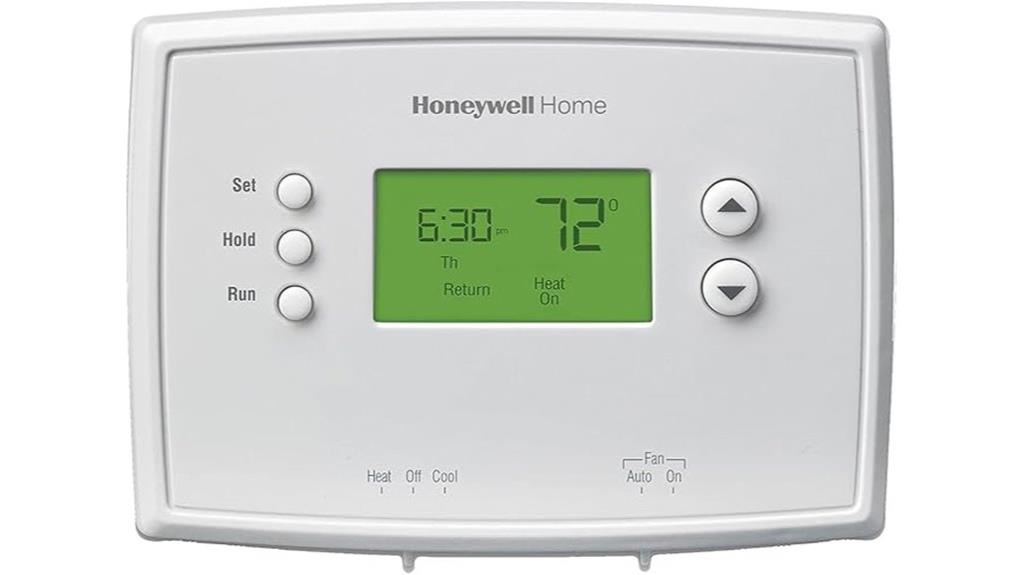
For anyone seeking an affordable and user-friendly thermostat, the Honeywell Home RTH2300B1038 5-2 Day Programmable Thermostat stands out as a top choice. With its easy DIY installation and compatibility with various heating and cooling systems, I found it perfect for my home. The 5-2 day programming allows me to set different schedules for weekdays and weekends, which is super convenient. Plus, its LED-backlit display makes it easy to read. I appreciate the battery change reminders and the fact it retains programming during power outages. Overall, it’s an efficient and budget-friendly option that keeps my home comfortable.
Best For: Individuals looking for an affordable, user-friendly thermostat that offers programmable scheduling for heating and cooling.
Pros:
- Easy DIY installation compatible with various heating and cooling systems.
- 5-2 day programming allows for separate weekday and weekend schedules.
- LED-backlit display for easy readability and battery change reminders.
Cons:
- Some users report issues with temperature consistency.
- Difficulties with wiring have been experienced by a few customers.
- Backlight functionality could be improved according to user feedback.
EMERSON Sensi Touch Wi-Fi Smart Thermostat (ST75W)
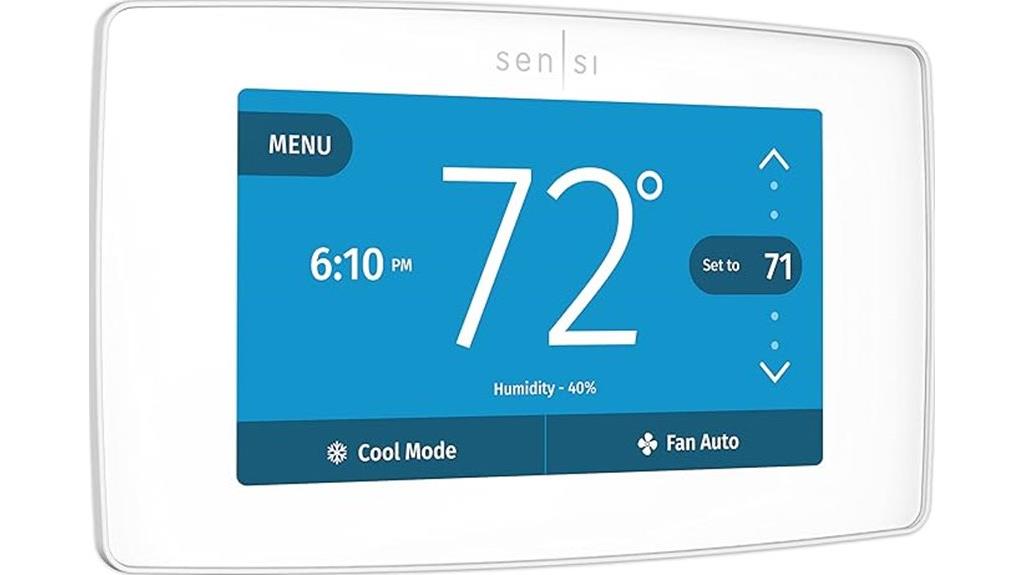
Smart homeowners seeking an energy-efficient upgrade will find the Emerson Sensi Touch Wi-Fi Smart Thermostat (ST75W) an ideal choice. With its sleek touchscreen display and Energy Star certification, it’s designed for peak performance. Installation’s a breeze, often taking just 30 minutes, thanks to its user-friendly app and built-in level. I love the energy savings—users report about 23% reductions through flexible scheduling and remote access. Plus, it’s compatible with major smart home systems like Alexa and Google Assistant. While some minor bugs were noted, overall feedback highlights its user-friendliness and clear interface, making it a solid investment for any home.
Best For: Homeowners looking for an energy-efficient, easy-to-install smart thermostat that integrates seamlessly with existing smart home systems.
Pros:
- Energy Star certified, helping users save approximately 23% on HVAC energy usage.
- Simple installation process, often completed in 30 minutes or less with user-friendly app guidance.
- Compatible with major smart home platforms like Amazon Alexa, Google Assistant, and Apple HomeKit.
Cons:
- Some users have reported minor bugs with SmartThings integration, affecting temperature reporting.
- Initial setup may cause frustrations, including app registration and connectivity issues.
- Users expressed a desire for additional features, such as low temperature alerts and filter change reminders.
Sensi Lite Smart Thermostat (ST25)
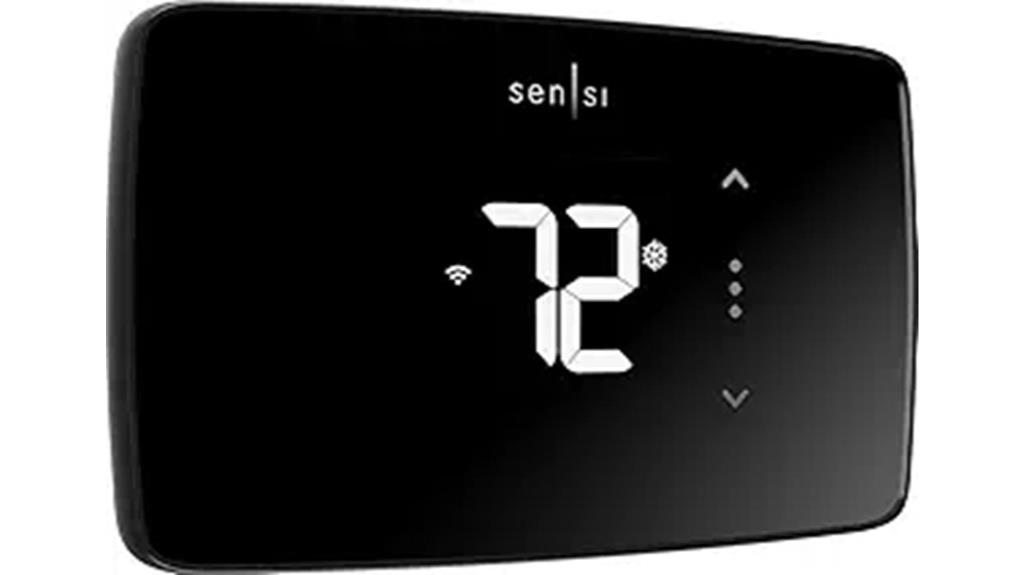
Looking for a budget-friendly option that still delivers advanced features? The Sensi Lite Smart Thermostat (ST25) might be just what you need. With easy DIY installation and compatibility with most HVAC systems, I found it simple to set up. This thermostat saves about 23% on energy costs through flexible scheduling and remote access via its top-rated app. Plus, it works seamlessly with Alexa, Google Assistant, and SmartThings. I appreciate its Energy Star certification and three-year warranty, providing peace of mind. If you want efficient temperature control without breaking the bank, the Sensi Lite is definitely worth considering!
Best For: Budget-conscious homeowners seeking a smart thermostat with advanced features and easy installation.
Pros:
- Energy savings of about 23% with flexible scheduling and remote access.
- Compatible with most HVAC systems and works with major smart assistants like Alexa and Google Assistant.
- Easy DIY installation with step-by-step instructions and a three-year warranty for added peace of mind.
Cons:
- Some users have reported concerns about customer support and limited operational information.
- Specific wiring issues may arise during installation for certain HVAC systems.
- Users are advised to avoid refurbished units due to potential malfunctions.
Google Nest Learning Thermostat – 3rd Gen
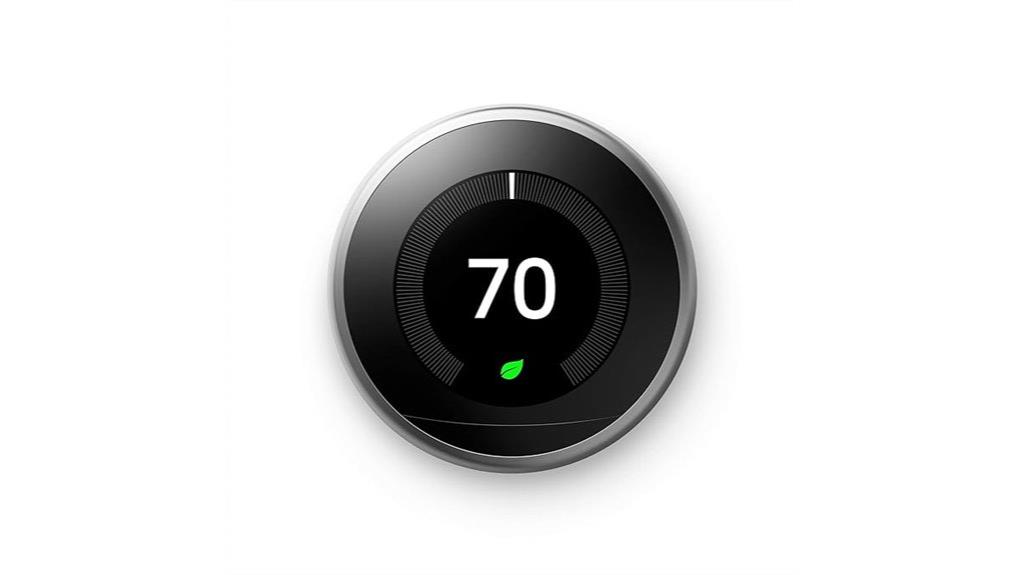
The Google Nest Learning Thermostat – 3rd Gen stands out for those who want a hands-free approach to home climate control, as it learns your preferences and adjusts settings automatically. With its sleek stainless steel design and bright display, it fits any home style effortlessly. I love the Auto-Schedule feature, which programs itself based on my habits, and the Home/Away Assist that saves energy when I’m not home. Plus, I can control it remotely through the Nest app. With potential savings of up to $145 annually, this thermostat not only keeps my home comfortable but also helps my wallet!
Best For: Individuals seeking a smart thermostat that learns their habits and offers energy savings with easy remote control.
Pros:
- Auto-Schedule: Learns user preferences and adjusts settings automatically for optimal comfort.
- Home/Away Assist: Saves energy by adjusting temperature when no one is home.
- Remote Control: Convenient management via the Nest app from anywhere.
Cons:
- Initial Cost: Higher upfront investment compared to traditional thermostats.
- Compatibility: May not work with all HVAC systems, requiring compatibility checks.
- Dependence on Wi-Fi: Requires a stable internet connection for full functionality.
meross Smart Thermostat for Home
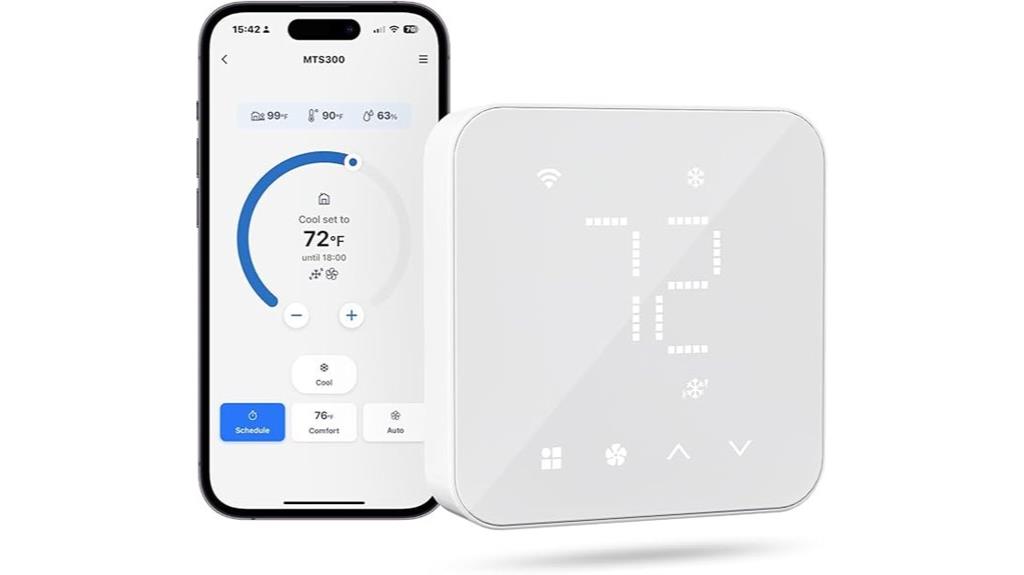
For those seeking an intuitive and energy-efficient heating solution, the Meross Smart Thermostat for Home stands out with its ability to work seamlessly with 95% of heating and cooling systems. I love the smart scheduling feature, allowing me to customize routines for up to 7 days. With the Meross app, I can control it from anywhere, ensuring I save energy and money—potentially up to 30% annually! The sleek design fits my home perfectly, and installation took less than 30 minutes. Plus, I appreciate the smart alerts for filter changes and system issues. It’s a fantastic investment!
Best For: Those looking for an intuitive, energy-efficient thermostat compatible with a wide range of heating and cooling systems.
Pros:
- Easy DIY installation in under 30 minutes with the Meross app setup wizard.
- Smart scheduling feature allows for customized routines up to 7 days.
- Potential energy savings of up to 30% annually compared to non-smart thermostats.
Cons:
- Requires a C wire for installation, which may not be available in all homes.
- Not compatible with electric baseboard heaters.
- Only compatible with Wi-Fi (2.4GHz) and may not support some advanced home automation systems.
Factors to Consider When Choosing Affordable Smart Thermostats

When I’m choosing an affordable smart thermostat, I think about a few key factors. Compatibility with my HVAC system and energy-saving features are at the top of my list, along with how easy it is to install. I also want to guarantee it integrates well with my smart home devices and has a user-friendly interface.
Compatibility With HVAC Systems
Choosing the right smart thermostat can be overwhelming, especially since compatibility with your HVAC system is vital. When I selected mine, I made certain it matched my specific system type, like conventional or heat pumps, since some models have limitations. I also checked for a C-wire, which many smart thermostats require for power. If you don’t have one, you might need an adapter. It’s important to confirm compatibility with setups like electric baseboard heaters or heating-only systems before buying. I found that some smart thermostats offer features like geofencing and remote sensors, enhancing their compatibility with various systems. Using compatibility check tools or consulting product specifications can help guarantee a seamless integration with your existing heating and cooling systems.
Energy Saving Features
While exploring affordable smart thermostats, I quickly realized that energy-saving features are essential for maximizing efficiency and reducing costs. Many of these devices are ENERGY STAR certified, which means they meet strict energy efficiency guidelines. I found that advanced features like auto-scheduling and geofencing can adjust temperatures based on my habits, potentially cutting energy consumption by up to 26% annually. Some models even provide detailed energy usage reports, helping me understand my heating and cooling patterns. Additionally, smart thermostats can automatically adjust settings when no one’s home, preventing unnecessary energy use. Integration with smart home systems allows for real-time monitoring, optimizing energy use based on my preferences. These features make a significant difference in saving both money and energy.
Installation Ease
Energy-saving features are fantastic, but if a smart thermostat is complicated to install, those benefits can quickly fade. I’ve found that many models offer easy DIY installation, often taking 30 minutes or less. Step-by-step app instructions make wiring and setup a breeze. User-friendly designs typically include a built-in level and illuminated terminals, so I didn’t need to call for professional help. Most smart thermostats work without a common wire (C-wire), though some might need it or a compatible power accessory. Online compatibility checkers and visual aids in installation apps help me identify my home’s wiring, minimizing errors. Clear instructions and accessible customer support further boost my confidence in managing my HVAC system.
Smart Home Integration
When I think about integrating a smart thermostat into my home, compatibility with existing smart home systems is essential. I want a device that works seamlessly with platforms like Amazon Alexa, Google Assistant, or Apple HomeKit for voice control and automation. It’s also vital that the thermostat can connect to smart sensors, allowing for room-specific temperature adjustments to enhance comfort and energy efficiency.
Additionally, I appreciate features like geofencing, which automatically adjusts settings based on my location, ensuring energy isn’t wasted when I’m away. Integration with my home security system is another plus, as it alerts me to temperature fluctuations that might indicate issues. Finally, a mobile app for remote management makes monitoring and scheduling a breeze, adding convenience to my daily routine.
User-Friendly Interface
Choosing an affordable smart thermostat means considering how user-friendly its interface is. I look for intuitive navigation that lets me adjust settings effortlessly, even if I’m not tech-savvy. A touchscreen display enhances my experience with clear visuals, making it easy to access various functions. I also appreciate mobile apps that offer straightforward controls for remote access; managing my home temperature from anywhere should feel seamless. Voice control compatibility with popular virtual assistants adds a layer of convenience, allowing me to make adjustments hands-free. Finally, clear setup instructions, often with visual aids, help me install the thermostat smoothly, ensuring it’s approachable, regardless of my skill level. A user-friendly interface truly makes a difference in my everyday life.
Warranty and Support
Although I’m excited about the features of a smart thermostat, I can’t overlook the importance of warranty and support. When choosing one, I pay close attention to the warranty length and terms, as these can vary greatly. A typical warranty ranges from 1 to 3 years, reflecting the manufacturer’s confidence in their product. I also consider customer support; some brands offer 24/7 assistance, which is crucial during installation or troubleshooting. Additionally, I appreciate a solid return policy—usually around 30 days—allowing me to test the thermostat risk-free. To gauge the level of support I might expect, I always read user reviews. They often reveal how responsive and helpful the customer service team is, which can make a big difference.
Frequently Asked Questions
Do Smart Thermostats Work With All HVAC Systems?
When I first looked into smart thermostats, I wondered if they’d work with my HVAC system. The good news is that most smart thermostats are compatible with a wide range of systems, including central heating and cooling, heat pumps, and even some older setups. However, I’d still recommend checking the specifications of both the thermostat and your HVAC system to guarantee a seamless fit. It’s definitely worth the effort for the convenience and energy savings!
Can I Control My Thermostat Remotely?
Absolutely, you can control your thermostat remotely! I love being able to adjust my home’s temperature from anywhere using my smartphone. Whether I’m at work or on vacation, I can easily make changes to keep things comfortable. Most smart thermostats offer user-friendly apps that let you set schedules, check energy usage, and even receive alerts. It’s convenient and gives me peace of mind, knowing I can always manage my home’s climate.
How Much Can I Save on Energy Bills?
You’d think saving money on energy bills is a myth, like a unicorn, right? Well, it’s not! I’ve found that by using a smart thermostat, I can save anywhere from 10 to 30% on my energy bills. That’s no joke! By adjusting the temperature when I’m not home, I’m not wasting energy – and my wallet appreciates it. So, if you’re like me, you’ll definitely notice a difference in your monthly expenses!
Are Smart Thermostats Easy to Install?
Absolutely, I found smart thermostats pretty easy to install! Most models come with clear instructions and all the tools you need. I was able to set mine up in about 30 minutes. If you’re comfortable with basic wiring, it’s a straightforward process. Plus, many brands offer helpful apps and customer support if you run into any issues. Overall, I’d say it’s definitely worth the effort for the convenience and energy savings!
Do They Require a Subscription for Full Functionality?
Did you know that smart thermostats can save you up to 23% on heating and cooling costs annually? When it comes to subscriptions, most smart thermostats don’t require one for basic functionality. However, some advanced features, like remote monitoring or energy reports, might need a subscription. I’ve found that even without paying extra, I still enjoy plenty of smart features that help me manage my home’s temperature efficiently.
Conclusion
To sum up, investing in an affordable smart thermostat can be a game-changer for your home’s energy efficiency and your wallet. Just like how people used to gather around the radio for news, we now rely on these smart devices to keep us comfortable and informed. By choosing the right thermostat, you’re not only saving money but also contributing to a greener planet. So, take the plunge and embrace the future of home temperature control!
